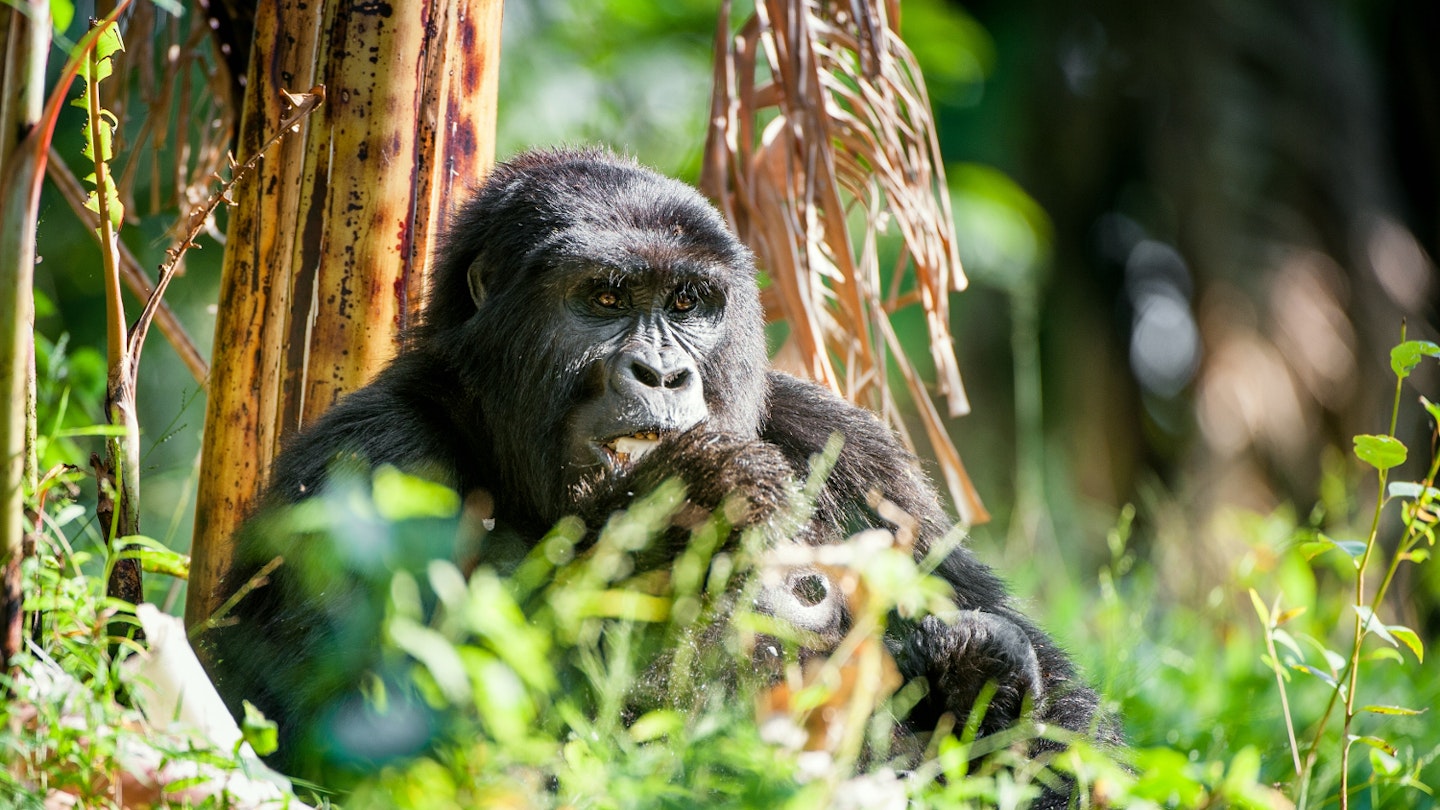Track the world’s biggest primates in Uganda’s dry(ish) season
Gazing into the deep brown eyes of an endangered mountain gorilla is a precious experience: perhaps only 700 or so individuals survive, of which around half roam the dense forests of Uganda’s Bwindi Impenetrable National Park. It’s an experience you’ll need to earn, tackling steep, muddy trails in altitudes up to 3000m, possibly for several hours. However, if you snag one of only eight permits available for each of the park’s nine habituated families, the rewards are luminous: an hour in the company of these gentle giants (a silverback male can reach 180 kg) is unforgettable. Moreover, the rest of the country holds its own, too. Nearby Queen Elizabeth National Park is renowned for tree-climbing lions, while you can track chimpanzees in Kibale National Park; beyond the far tip of Lake Albert, the Nile thunders over Murchison Falls, and there’s fine trekking in the Rwenzori Mountains.
Trip plan: From Entebbe, Uganda’s international airport, fly to Ishasha airstrip for Bwindi. Add time in Queen Elizabeth, Kibale, and Murchison Falls national parks.
Need to know: Gorilla tracking permits valid for one day must be purchased in advance, currently US$600 for foreign non-residents (US$450 in April, May, and November). Under-15s aren’t permitted on gorilla-tracking excursions.
Other months: Dec-Feb & Jun-Sep – driest months, best for trekking; Mar-May – wet, good birding; Oct-Nov – wet, gorilla permits may be easier to obtain.
Track wolves and lynx through eastern Poland’s epic wintry wilderness
Here be giants: wisent, or European bison – the continent’s largest land mammal – stand up to 1.8m high and can weigh nearly a tonne. Białowieża National Park, a sprawling reserve that’s part of the primeval Białowieża Forest spanning the borders of Poland and Belarus, is the stronghold of the bison, reintroduced here in 1929 after wild bison became extinct in Europe in 1919; about 500 now live free in the Polish part of the forest. Consequently, midwinter is the time for a thrilling expedition tracking bison, wolf, and elk (moose) footprints through the snow, and watching for boar, lynx, and pine martens. If you don’t catch a glimpse of wild bison, be awed by captive-bred beasts at the show reserve. Moreover, nearby Biebrza National Park is another winter wonderland, a marshy valley where the big draw is elk – head out to track one of the reserve’s 600 residents, and you might also enjoy encounters with otters, boars, or wolves.
Trip plan: Fly to Warsaw before going east to Białowieża and Biebrza national parks – allow at least four days for the trip to Białowieża alone, a week to include both parks.
Need to know: Temperatures average about -5°C (23°F) in January, and may drop much lower – pack warm clothes.
Other months: Dec-Feb – winter, snowy; May-Oct – warm, good wildlife-watching; Nov & Mar-Apr – cold, can be wet.
Watch hundreds of thousands of grazing wildebeest in the Serengeti, Tanzania
If those images of wildebeest plunging through croc-infested rivers, or of lions stalking the herds across the vast Masai Mara have enticed you, think on this: each of those gnus came from somewhere. And that somewhere is their mother, who fattened up on the grasses of the southern Serengeti before calving in one of the world’s great synchronised breeding events, producing up to half a million young each year. January is the time to explore this less-visited patch of Africa, watching herds of wildebeest and zebra as they munch their way across the short-grass plains, stocking up on calories before giving birth from late January – which is also when predator action can be thrilling. Perhaps 1.5 million gnus continue northwest on their cyclical migration around April. During the ‘short rains’, discounts may be found at some safari camps. You’re also close to Olduvai Gorge, the famed ‘Cradle of Mankind’ known for finds of early hominid remains, and the wildlife-dense Ngorongoro Crater.
Trip plan: Fly into the Seronera airstrip from Arusha, and base yourself at a lodge in that zone.
Need to know: Most non-African nationals require a visa, usually available on arrival at major airports for US$50.
Other months: Dec-Feb – dry, wildebeest grazing; Mar-May – long rains; Jun-Sep – peak season, migration in north Serengeti and Masai Mara; Oct-Dec – short rains.
Bask in near permanent daylight in the enormous white wilderness at the end of the world
High summer on the Antarctic Peninsula brings endless, warm days – well, it’s all relative, isn’t it? Temperatures ‘soar’ to freezing point or even a little higher in the middle of the austral summer. Certainly, the locals appreciate it. In January you’ll see – and hear – vast penguin colonies at their most raucous, with chicks (hatched at new year) demanding to be fed, and seal pups on South Georgia, while whale sightings rise towards the end of the month. Weather can’t be guaranteed, of course, not least on the Drake Passage between Tierra del Fuego and the peninsula – you might get the ‘Drake Shake’ or just as easily the ‘Drake Lake’ – but at least in January you have a good chance of sailing among gargantuan icebergs and soaring cliffs while sunshine glints off water and ice.
Trip plan: Most cruises heading for the Antarctic Peninsula sail from Ushuaia on Tierra del Fuego, southern Argentina, and last around 11 to 14 days. Adding South Georgia increases duration by a few days.
Need to know: The Drake Passage crossing takes at least two days in each direction. It’s possible to fly from Punta Arenas (Chile) to King George Island on one or both legs, avoiding the crossing.
Other months: Nov-Mar – summer, Antarctica accessible to tourist ships; Apr-Oct – winter, dark, cold, difficult to visit.





